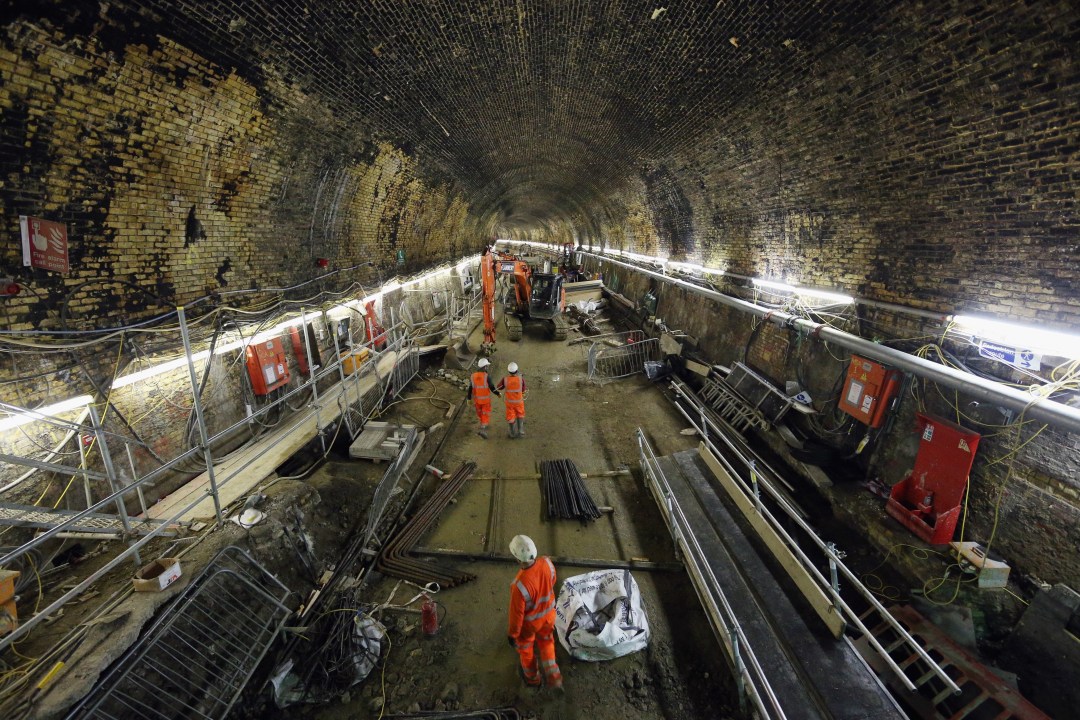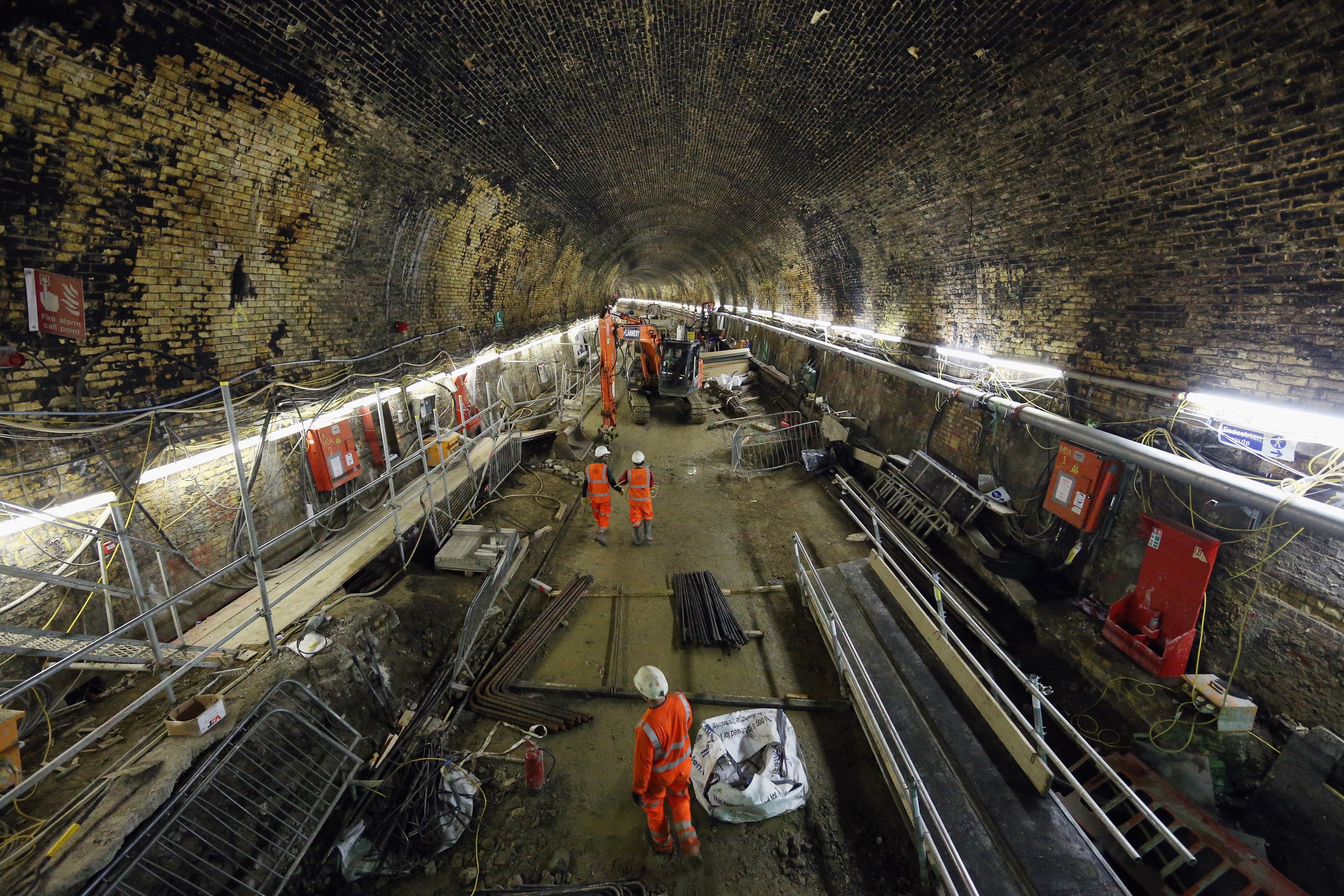Phyllis has gone to Tottenham Court Road, but Ada is having a day off. In fact she’s slumbering deep below us, just south of Bond Street station with her head under Grays Antique Centre.
Phyllis and Ada are twin sisters, 140 metres long, weighing 1,000 tonnes each. I’m imagining them as domesticated versions of those monstrous sandworms on the planet -Arrakis in Frank Herbert’s Dune, with their crystal teeth and ‘bellows breath of cinnamon’. They are the tunnel-boring machines that are munching through London’s sub-terrain from Royal Oak to Farringdon where, some time in autumn 2014, they will bump into their cousins Elizabeth and Victoria, coming the other way from Limmo Peninsula in Docklands.
And they are the pride of the team who are building Crossrail, the line from Maidenhead and Heathrow in the west to Shenfield and Abbey Wood in the east, due to open in 2018, that is Europe’s biggest construction project and one of London’s liveliest subjects of saloon-bar debate. For its advocates, Crossrail will be a transformative addition to passenger capacity and connectivity across the capital, having served as a £15 billion load of Keynesian fertiliser thanks to its construction during the economic downturn. To its detractors, it’s one more public-sector folly we can’t afford, as well as a massive annoyance for West End businesses, shoppers and residents. I’m on site at Bond Street in hard hat and hi-viz suit to form my own opinion.
My guide is Crossrail chairman Terry Morgan, a veteran of senior posts at BAE Systems, Land Rover and Tube Lines, the entity that runs the Jubilee, Northern and Piccadilly components of the Underground. Now he sits between the contractors doing the digging and the people putting up the money — £7 billion from the Mayor of London, £5 billion from the Chancellor, £2 billion from Network Rail and £1 billion direct from the City and business. He’s a genial Welshman with an engineer’s gift for explaining complexities, and I’m relying on his descriptions of Phyllis and Ada because visitors like me aren’t allowed down to the deepest level of the workings to witness the great machines cutting into the clay, building tunnel segments as they go and conveying the spoil back through their innards to be transported to the Thames estuary, there to be formed into a new sanctuary for wading birds.
What I am allowed to see is the hole in the ground between Gilbert Street and Davies Street which will become the ticket hall and escalator access for the western end of the Crossrail platform, whose eastern entrance will be at Hanover Square. The new trains, carrying up to 1,500 passengers and passing every two-and-a-half minutes at peak times, will be twice as long as Tube trains. An extra 65,000 travellers a day are expected to use this interchange with the Central and Jubilee lines — but it looks modest at first, like any other half-built basement structure, a muddle of bare concrete, slippery scaffolding, steel mesh and safety notices. Down at Level Four, however, just above Ada’s lair, you begin to understand not just the monumental scale but the special engineering challenge.
Here is a cliff-face of slimy London clay, and a fleet of diggers scooping it out to complete the station’s concrete ‘box’. But that’s the easy part; on an uninterrupted run, Phyllis has been known to advance 100 metres in a single day. What’s difficult is the negotiation of a giant spaghetti-tank of sewers, cables and Tube tunnels; the health risks of leptospirosis from rats and even (it was claimed) anthrax and bubonic plague from ancient graves; the tight truck routes in and out of ground-level stockades; and the potential damage to surrounding property from Ada’s vibrations.
There are more than 50 sites like this along the tunnelled central section of the route, and the project has been recognised as setting a new global benchmark for urban excavation. Artwork showing fat Crossrail tunnels dwarfing the Central Line below Oxford Street illustrates just how big this thing is. ‘We’ve had delegations from all over the world come to see how we’ve done it,’ says Morgan. He’s also had every minister of the coalition government wanting to take a look, now there’s an aura of success around the project. The post-Olympic mood has made it OK to be photographed alongside unfinished big-budget public works. First discussed in 1948, on the drawing board in various forms under the name ‘Crossrail’ since 1974, this one was finally signed off in Downing Street by Gordon Brown at the urging of his transport minister Andrew Adonis — whom Morgan praises for recognising that long-term infrastructure has to be considered above party politics.
Other sources say Brown said yes that day because his attention was distracted by trying to decide whether to call a snap general election. Some digging began in 2009, but the only unwavering champion was Mayor Boris. Commitment from Westminster looked slippery until after the 2010 election and a review that shaved £1 billion off the costs in exchange for a year on the timetable. From then on, says Morgan, funding has been assured and momentum has been tangible.
Not everything is ticketyboo, however. If infrastructure is back in fashion, ‘public-private partnership’ has gone the way of Gordon Brown — a case in point being Morgan’s old firm, the Tube Lines consortium that had to be bought in by Transport for London when it ran out of cash in 2010. The government’s decision in March to abandon the use of private finance to fund Crossrail rolling stock has left a question mark over the timely delivery of trains — allowing Labour spokesman Maria Eagle to claim ‘yet another humiliating transport shambles’. No doubt she’ll have more to say about the number of jobs safeguarded by the train contract, since all the bidders are foreign-owned, though some have UK factories. But on the whole, there’s no evidence at this stage even for point-scoring oppositionists to suggest that the 73-mile route, 26 miles of it in new tunnels, can’t be completed on time and on budget.
That will be a colossal achievement, whether or not you give credence to the ‘business case’ estimate of a £42 billion boost to GDP over 60 years. The business case for the HS2 rail link to the north of England, which gives a figure of £47 billion, came under attack recently from a potent combination of the National Audit Office, public accounts committee chairman Margaret Hodge, and our own editor writing in the Daily Telegraph.
But what can be confidently predicted for Crossrail is that it will make journeys into and across London smoother than ever before — half an hour from Heathrow to the City, 16 minutes from Paddington to Canary Wharf, 1.5 million commuters brought within 45 minutes of their workplace. We don’t yet know what the fares will be but it will be within the Oyster card network and I suspect travellers will swiftly take to it. Wherever Boris happens to be in 2018, you may be sure that he will declare it a triumph. Meanwhile, Crossrail’s outer stations are already hotspots in a house-building revival. And its manpower requirements, rising to 14,000 at the peak of construction, are the catalyst for a huge training programme. By the time the line is finished, Britain will have the world’s most skilled workforce for this kind of engineering.
And one obvious way to deploy them will be on Crossrail 2 from Wimbledon to Alexandra Palace (or a longer version from Surrey to Hertfordshire) for which a consultation was launched by Boris, with Lord Adonis in support, on the day of my visit. That one is costed at £16 billion and the talk is of ‘construction in the 2020s’, so it could still happen ahead of HS2. Terry Morgan thinks it would be wise to get on with it quickly, tackling the ‘enabling works’ while his team is still in place.
I wrote not long ago that some transport schemes demand to be embarked upon not on the basis of spurious ‘business case’ arithmetic but as ‘an act of faith in the future’, underpinned by the certainty that existing infrastructure will crumble and gridlock will overwhelm us if we do nothing. So I’m with Boris on Crossrail: Londoners need it, they’re largely paying for it themselves, it will make their lives easier — and it will remind us all of something until recently forgotten, that we’re capable of mighty feats of engineering.








Comments